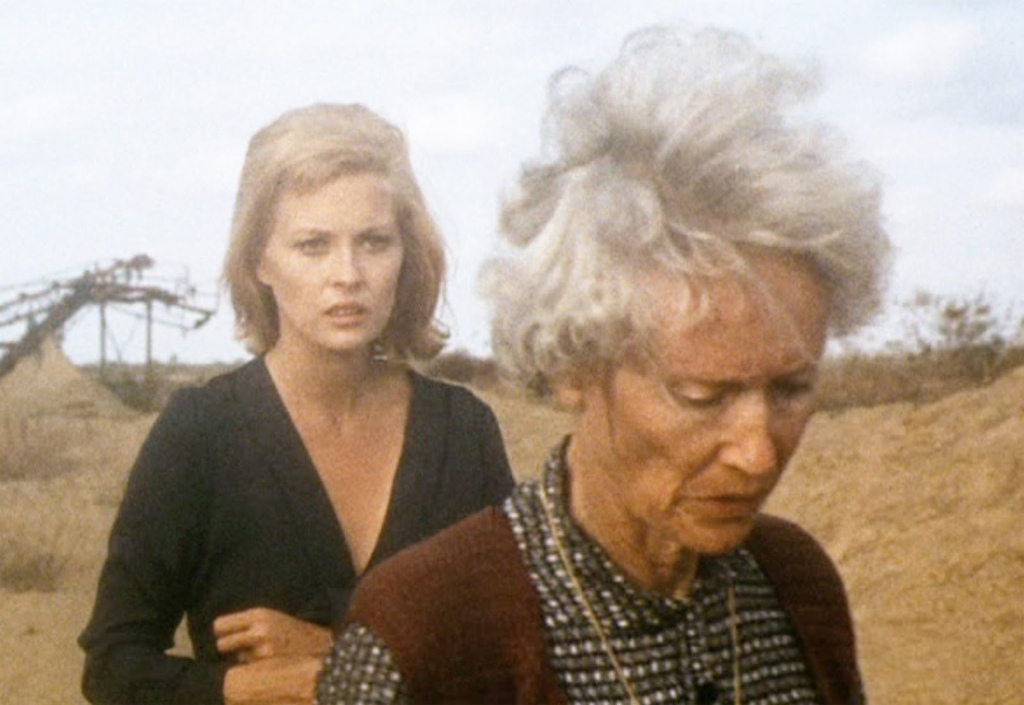Overview:
Clyde catches Bonnie, who has snuck away from the gang and ran into a dying wheat field. She says to him that she wants to see her mother again, and Clyde agrees despite the risk, and in the next scene Blanche, Buck, Bonnie and Clyde enjoy a family re-union at an abandoned industrial site. There is an air of tension to the scene which culminates when Bonnie’s elderly and disapproving mother confronts Clyde and questions his plans and the safety eh van provide for Bonnie. His charm does not work on her, and she finishes by saying “You best keep running, Clyde Barrow” and leaves the couple alone by the site.
Key Elements:
Cinematography –
At the beginning of this scene, the style of filmmaking swaps between conventional American commercial filmmaking and the French New Wave style which influenced Arthur Penn’s direction. The scene is filmed on long lenses in the French style, and the camera movements following Clyde and improvised, causing the movement to be rapid, sudden and disconcerting to the audience. However, as Clyde runs next to the car, the camera filming moves backwards on a rig to produce a steady image, mo vying to show Buck as Clyde leans in to talk to him. An extreme wide shot is used as the actors improvise, running across the field. As the lighting cannot be controlled, because the film was shot on location in the French style, the shadow in this wide shot is no longer there when the scene cuts to a closer shot lol Bonnie running. Even in this wide shot though, the camera cranes upwards to follow the movement of the actors up the screen, a more traditional style of Hollywood filmmaking. In the closer shot, a what leaf obstructs the foreground, a sign of shooting on location rather than on a controlled, choreographed set.
Bonnie’s mother is shown in separate shots to everyone, showing her isolation and disapproval. During this picnic scene, the camera shoots through a car windscreen to serve as a filter that makes the image more grainy and giving the scene a dream-like quality. This is also done through washed out colours and far-away telephoto lends shots used for close-ups, such as the one with Bonnie’s mother, separating her from an incoherent, blurred background and adding a strange, incomplete feel to the shot. It gives the scene an other-worldly like atmosphere, adding a surreal quality to this entire sequence and making it feel more profound. This atmosphere serves as a metaphor, as the meaning behind the character’s’ expressions and the heavenly and strange atmosphere to the scene signifies that Bonnie and Clyde will die. This confusing lens the scene is shot through also prevents the audience from seeing clearly the fact that this scene takes place in a hidden industrial wasteland. This is symbolic of the direness of the characters’ situation, showing that they have to hide to survive, and also signifies the distractions Ned happiness they get when they are seen spending time together and playing in the pit. The location is shown through an establishing wide shot at the start of the scene and one at the end of it, a more conventional American style of cinematography.
Bonnie’s mothers’ words of “You best keep running, Clyde Barrow” are made to look more prophetic by the use of a long lens which isolates her from the background and the close up isolating her from everyone else, although this final conversation is done in traditional Hollywood style through shot-reverse-shots, close ups and over-shoulder shots.
Sound –
Editing –
The dissolve cut to the picnic scene is an example of traditional American commercial cinema editing. However, the scene with the family swaps between slow and normal motion and missing frames shots disconcert the audience to create an abstract and dream-like quality in the French New Wave style. There is also a moment of discontinuity when Bonnie;s mother is looking at Clyde in one close up and then down in the next.
Mise-En-Scen –
The dying wheat field serves as a metaphor for the fact that Bonnie and Clyde are destined for death. This is also signified in the funeral-like clothing that the characters are having a family reunion.We see how Bonnie’s character has changed through her lack of bright makeup and her more serious demeanour here.
Performance –
Blanche and Buck seems to be regretful, signifying that they know that Bonnie and Clyde will die, similarly to Bonnie’s mother’s sad demeanour, as opposed to Bonnie’s unsure expression and Clyde’s (and the children’s) clear ignorance. We see that Clyde’s boyish charm does not work on her mother as it did Bonnie at the start of the film, allowing for the mother so speak some actual truth for the first time in the film. In the final shot of the scene, Bonnie and Clyde are isolated, Clyde seeming confused and Bonnie worried, oscillated in a wide shot by being kept far away from Buck and Blanche who are clearly upset, foreshadowing the clear end of Bonnie and Clyde. It also leaves the entire gang alone in frame, showing their isolation from everyone else.
Context:
Representation and Aesthetics:
Auteur:

You must be logged in to post a comment.